Rivian Bundle
Can Rivian Conquer the EV Adventure?
The electric vehicle (EV) revolution is reshaping the automotive industry, and Rivian has emerged as a key player in this transformation. Founded in 2009, Rivian quickly captured attention with its innovative approach to electric adventure vehicles. This report dives deep into Rivian's Rivian SWOT Analysis, exploring its growth strategy and future prospects in the dynamic EV market.
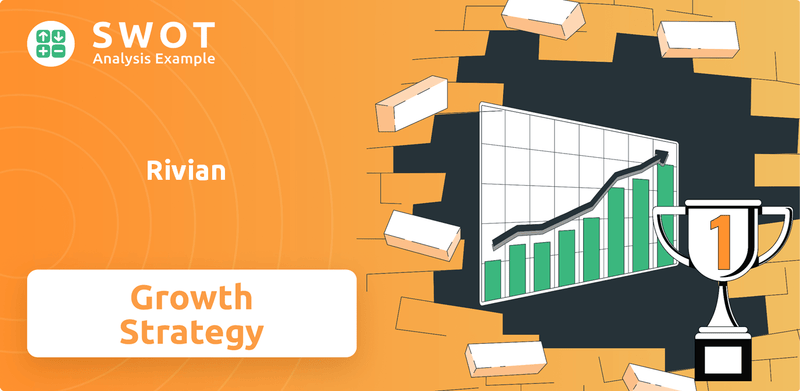
Rivian's journey from an EV startup to a recognized brand with the R1T and R1S showcases its potential. The company's success hinges on its ability to scale production, innovate, and navigate the competitive landscape. Understanding Rivian's plans for expansion, technological advancements, and financial performance is crucial for anyone interested in sustainable transportation and the long-term investment potential of this exciting company.
How Is Rivian Expanding Its Reach?
Rivian's expansion initiatives are central to its Rivian growth strategy and future success in the electric vehicle market. The company is focused on scaling production, entering new market segments, and potentially expanding geographically. These efforts are designed to solidify its position as a key player among EV startups and contribute to the growth of sustainable transportation.
A primary goal is to increase the production capacity of its existing models, the R1T and R1S, along with the Rivian Commercial Van (RCV) for Amazon, at its Normal, Illinois plant. Rivian aims to achieve positive gross profit by Q4 2024, driven by production efficiencies and cost reductions. This financial milestone is critical for demonstrating the company's ability to operate profitably and attract further investment.
The introduction of the R2 platform is a significant step towards accessing a broader customer base. The R2 is expected to begin production in 2026 at a new plant in Georgia, with an anticipated starting price of $45,000. This move is crucial for Rivian to compete in a more mass-market segment, increasing its potential market share.
The R2 platform is a key component of Rivian's expansion strategy. Production is slated to begin in 2026 at a new plant in Georgia. The target price point of $45,000 is designed to attract a wider consumer base.
Rivian is focused on ramping up production at its Normal, Illinois plant. The company aims to achieve positive gross profit by Q4 2024. Increased production efficiency is key to achieving profitability.
Rivian has unveiled the R3 and R3X models, which are smaller and more affordable vehicles based on the R2 platform. This diversification allows Rivian to target different consumer preferences. The R3 and R3X are designed to broaden Rivian's market appeal.
The R2 platform is designed with global markets in mind, suggesting future expansion beyond North America. Specific timelines for international expansion of consumer vehicles are not yet extensively detailed. International expansion is a key part of Rivian's long-term strategy.
Rivian is also exploring direct-to-consumer sales models and expanding its service infrastructure, including its charging network. These efforts are designed to support its growing customer base and improve the overall ownership experience. To learn more about how Rivian is approaching its marketing efforts, consider reading the marketing strategy of Rivian.
Rivian's expansion strategy is multifaceted, focusing on production capacity, new product offerings, and market reach. Key initiatives include the R2 platform launch, production ramp-up, and potential international expansion.
- Ramping up production of R1T, R1S, and RCV at the Normal, Illinois plant.
- Launching the R2 platform in 2026 at a new plant in Georgia.
- Introducing the R3 and R3X models to diversify the product portfolio.
- Exploring international expansion opportunities with the R2 platform.
Rivian SWOT Analysis
- Complete SWOT Breakdown
- Fully Customizable
- Editable in Excel & Word
- Professional Formatting
- Investor-Ready Format
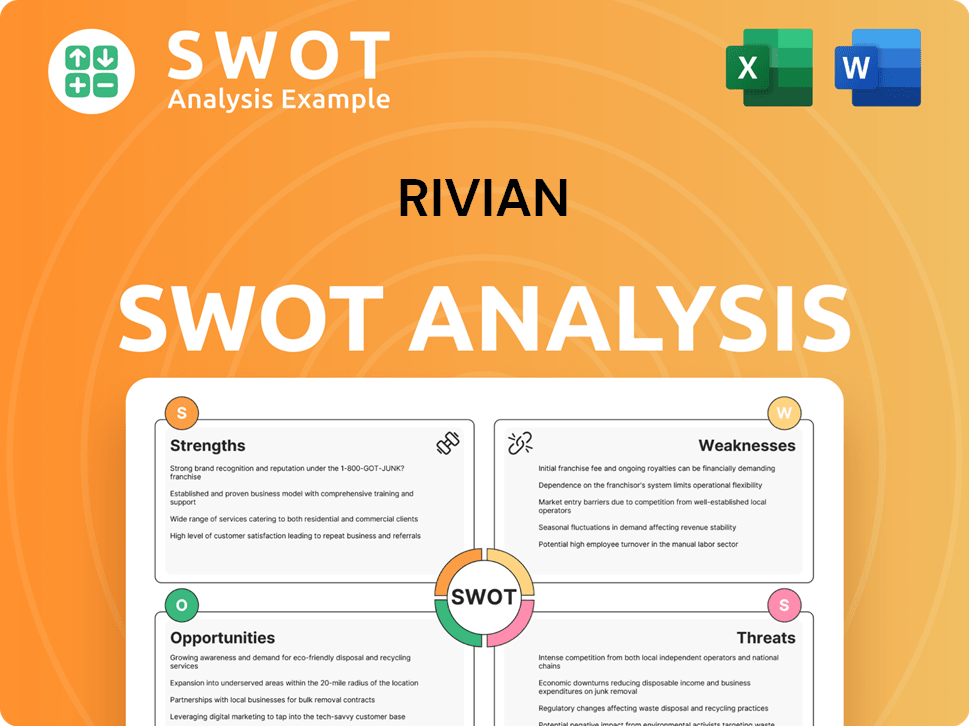
How Does Rivian Invest in Innovation?
Rivian's innovation and technology strategy is central to its Rivian company growth strategy and future prospects. The company focuses on developing proprietary EV platforms, advanced battery technology, and integrated software solutions. This approach aims to enhance vehicle performance, improve user experience, and promote sustainability, which are key differentiators in the electric vehicle market.
A significant part of Rivian's strategy involves substantial investment in research and development. This includes the in-house design of the Enduro drive unit, which is intended to boost efficiency and reduce costs. Rivian's vehicles also feature a sophisticated software platform that supports over-the-air updates, ensuring continuous improvements in vehicle features, performance, and diagnostic capabilities.
The introduction of the R2 platform marks a major technological advancement, focusing on a more modular and cost-effective design. This platform aims to maintain Rivian's core attributes of performance and adventure capability. Rivian's commitment to sustainability is also evident in its technology strategy, with efforts to optimize battery chemistry for increased range and faster charging, along with exploring sustainable manufacturing processes.
Rivian designs its own EV platforms, which allows for customization and control over vehicle performance. This approach is crucial for differentiating itself in the competitive electric vehicle market.
Rivian invests in battery technology to improve range, charging speed, and overall efficiency. This is a key area for enhancing the appeal of its vehicles to consumers.
The company develops integrated software solutions to enhance the user experience and enable over-the-air updates. This ensures that vehicles remain up-to-date with the latest features and improvements.
The in-house designed Enduro drive unit is a critical component. It is designed to improve efficiency and reduce costs, which contributes to the Rivian growth strategy.
The R2 platform represents a significant technological advancement. It focuses on a more modular and cost-effective design while maintaining Rivian's core attributes.
Rivian is committed to sustainability, focusing on battery chemistry optimization and exploring sustainable manufacturing processes. This aligns with the growing demand for eco-friendly vehicles.
Rivian's technological advancements are centered on proprietary designs and sustainable practices. The company's approach to innovation is designed to create a competitive advantage in the electric vehicle market.
- Patents: Rivian holds numerous patents related to its EV architecture, battery packs, and vehicle features, which highlights its commitment to proprietary innovation.
- Over-the-Air Updates: The software platform allows for continuous improvements in vehicle features and performance.
- Battery Technology: Efforts to optimize battery chemistry for greater range and faster charging are ongoing.
- Sustainable Manufacturing: Exploring sustainable manufacturing processes is a key part of Rivian's strategy.
Rivian PESTLE Analysis
- Covers All 6 PESTLE Categories
- No Research Needed – Save Hours of Work
- Built by Experts, Trusted by Consultants
- Instant Download, Ready to Use
- 100% Editable, Fully Customizable
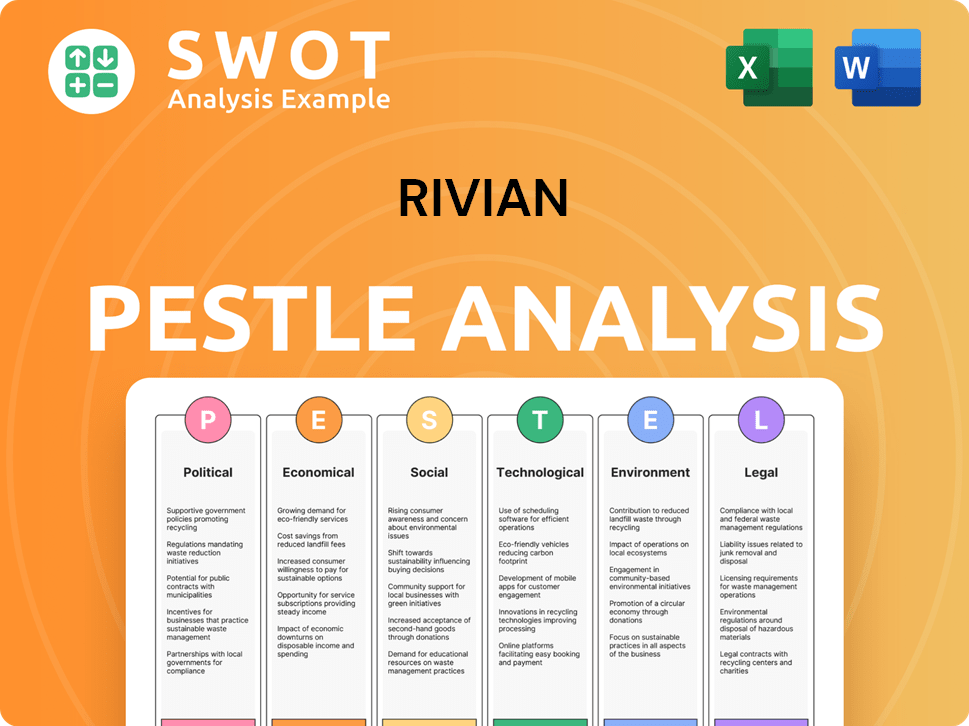
What Is Rivian’s Growth Forecast?
The financial outlook for the company, a prominent player in the electric vehicle market, is centered on achieving profitability and sustainable growth. This strategy is crucial for the company's long-term success in the competitive EV startup landscape. The company's ability to scale production, manage costs, and secure its financial position will be key factors in determining its future prospects.
In the first quarter of 2024, the company demonstrated positive momentum. The company reported revenue of $1.20 billion, surpassing analyst expectations. The company also delivered 13,588 vehicles during this period. This performance reflects the company's ongoing efforts to increase production and meet growing demand for its electric vehicles.
The company is targeting positive gross profit in the fourth quarter of 2024. This is a critical milestone that would indicate improved operational efficiency. The company's focus on cost reduction and operational improvements will be essential for achieving consistent profitability in the coming years. For a deeper dive into the company's financial structure, consider exploring the Revenue Streams & Business Model of Rivian.
The company's Q1 2024 revenue reached $1.20 billion, exceeding expectations. The company delivered 13,588 vehicles in Q1 2024, showing production growth. The company projects a full-year 2024 production of 57,000 vehicles.
The company anticipates capital expenditures of $1.7 billion in 2024. The company's substantial cash reserves, totaling $7.9 billion as of March 31, 2024, support ongoing operations. These funds are crucial for R2 platform development and expansion initiatives.
The company is aiming for positive gross profit in Q4 2024. Analyst forecasts anticipate revenue increases as production scales up. The company's focus is on improving operational efficiency and reducing costs.
Despite a net loss of $1.45 billion in Q1 2024, the company maintains a strong cash position. The company's robust cash reserves provide a financial cushion. This supports the company's strategic initiatives.
Rivian Business Model Canvas
- Complete 9-Block Business Model Canvas
- Effortlessly Communicate Your Business Strategy
- Investor-Ready BMC Format
- 100% Editable and Customizable
- Clear and Structured Layout
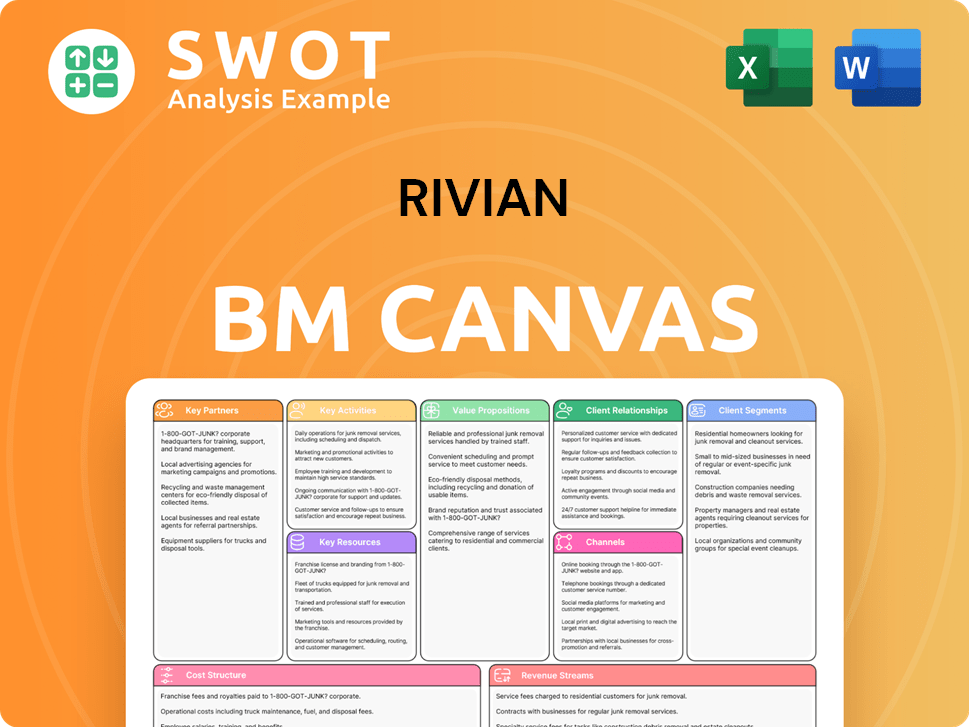
What Risks Could Slow Rivian’s Growth?
The path ahead for the company is fraught with potential risks and obstacles. Navigating the competitive landscape of the electric vehicle market and scaling up production are key challenges. The company's success hinges on its ability to overcome these hurdles while capitalizing on opportunities within the sustainable transportation sector.
The company faces several significant challenges that could impact its growth. These include intense competition from established automakers and other EV startups, supply chain disruptions, and evolving regulations. Successfully addressing these issues is crucial for realizing its ambitious growth plans and solidifying its position in the electric vehicle market.
The company's future prospects are closely tied to its ability to manage these risks effectively. External factors, such as economic downturns and fluctuating raw material costs, could also shape its trajectory. Understanding and mitigating these challenges will be vital for long-term success, as highlighted in an analysis of the Target Market of Rivian.
The electric vehicle market is becoming increasingly crowded. Established automakers, along with other EV startups, are all vying for market share. This intense competition puts pressure on the company to innovate and differentiate itself.
Supply chain disruptions, particularly for critical components like batteries and semiconductors, pose a significant risk. These disruptions can lead to production delays, increased costs, and ultimately, affect the company's ability to meet demand. The company has taken steps to mitigate some of these risks, such as bringing more component manufacturing in-house.
Evolving emissions standards and incentives for EV adoption can impact the company's operations and market demand. Changes in government policies can create both opportunities and challenges. The company must stay agile and adapt to the changing regulatory landscape to maintain a competitive edge.
Advancements in battery technology, autonomous driving, and charging infrastructure could rapidly shift industry dynamics. The company needs to invest in research and development to stay ahead of these technological advancements. Staying competitive requires continuous innovation.
Scaling its manufacturing operations and expanding its service network presents internal resource constraints. The company must manage its resources efficiently. Effective resource allocation is critical to support its growth plans.
Economic downturns can impact consumer spending on premium vehicles. The increasing cost of raw materials for EV batteries could also affect profitability. External economic factors can have a significant impact on the company's financial performance.
The company has faced supply chain issues, particularly for batteries and semiconductors. In 2023, the company experienced production challenges due to these issues. Securing reliable and cost-effective supply chains is critical for meeting production targets and controlling costs. The company is working to diversify its suppliers and bring more component manufacturing in-house to mitigate these risks.
The electric vehicle market is highly competitive, with established automakers and other startups vying for market share. The company competes with Tesla, Ford, General Motors, and other EV manufacturers. Success depends on differentiating its products, building brand recognition, and providing excellent customer service. The company's focus on the adventure market and unique vehicle designs are key differentiators.
The company's financial performance is subject to market volatility and economic conditions. The company's stock performance has fluctuated since its IPO, reflecting the challenges and opportunities in the EV market. The company's ability to achieve profitability is crucial for long-term sustainability. The company's financial results for 2023 showed increased revenue but also significant losses.
Advancements in battery technology could impact the company's competitive position. Innovations in battery range, charging speed, and cost are critical. The company is investing in battery technology to stay competitive. The company is exploring partnerships and internal development to improve battery performance and cost-effectiveness.
Rivian Porter's Five Forces Analysis
- Covers All 5 Competitive Forces in Detail
- Structured for Consultants, Students, and Founders
- 100% Editable in Microsoft Word & Excel
- Instant Digital Download – Use Immediately
- Compatible with Mac & PC – Fully Unlocked
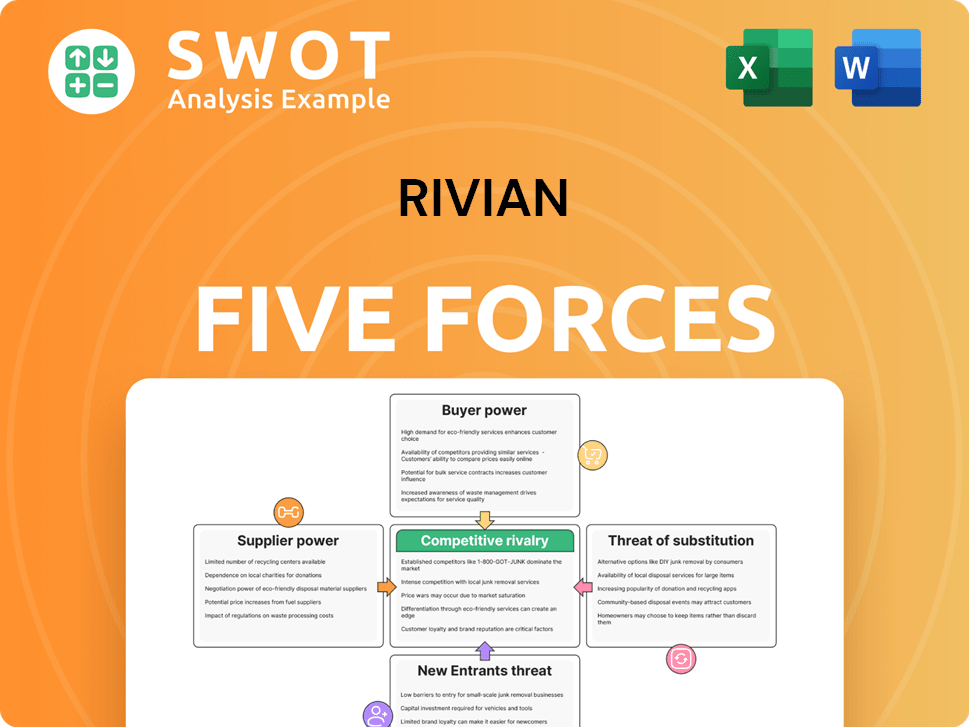
Related Blogs
- What are Mission Vision & Core Values of Rivian Company?
- What is Competitive Landscape of Rivian Company?
- How Does Rivian Company Work?
- What is Sales and Marketing Strategy of Rivian Company?
- What is Brief History of Rivian Company?
- Who Owns Rivian Company?
- What is Customer Demographics and Target Market of Rivian Company?
Disclaimer
All information, articles, and product details provided on this website are for general informational and educational purposes only. We do not claim any ownership over, nor do we intend to infringe upon, any trademarks, copyrights, logos, brand names, or other intellectual property mentioned or depicted on this site. Such intellectual property remains the property of its respective owners, and any references here are made solely for identification or informational purposes, without implying any affiliation, endorsement, or partnership.
We make no representations or warranties, express or implied, regarding the accuracy, completeness, or suitability of any content or products presented. Nothing on this website should be construed as legal, tax, investment, financial, medical, or other professional advice. In addition, no part of this site—including articles or product references—constitutes a solicitation, recommendation, endorsement, advertisement, or offer to buy or sell any securities, franchises, or other financial instruments, particularly in jurisdictions where such activity would be unlawful.
All content is of a general nature and may not address the specific circumstances of any individual or entity. It is not a substitute for professional advice or services. Any actions you take based on the information provided here are strictly at your own risk. You accept full responsibility for any decisions or outcomes arising from your use of this website and agree to release us from any liability in connection with your use of, or reliance upon, the content or products found herein.